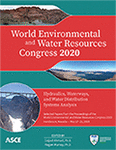World Environmental and Water Resources Congress 2020
Enhancing Maximum Scour Depth Determination for Spur Dikes Using a Validated Two-Dimensional Model
Publication: World Environmental and Water Resources Congress 2020: Hydraulics, Waterways, and Water Distribution Systems Analysis
ABSTRACT
The introduction of spur dikes into a river flow field can help to improve the stability of a river channel. While the flow velocity directly at the spur dike tip or crest may increase, a large embayment area downstream of the spur dike will form with reduced flow velocities. Due to the increase in flow velocity at the spur dike, a scour hole will form. Many hydraulic structures are tested by building scaled models, which is very costly and lacks versatility to model all factors correctly. The use of two-dimensional numerical models allows for increased efficiency and accuracy of hydraulic modeling. This allows for enhancing relationships between dynamic variables and the estimated scour depth. The length of the spur dike and the flow rate were varied in the experiments. It was found that as the length of a spur dike increases, the depth of the scour also increases. This held a stronger correlation than the increase in flow rate. A relationship was developed between the maximum flow velocity, the upstream flow velocity, and the upstream Froude number to determine the maximum scour depth. This relationship proved to be more accurate than past relationships proposed using data from physical model analysis. The new relationship lowered the percentage-error from 14% to 1% when the predicted scour depths were compared with the measured scour depths. The error was reduced from 7.3% to 1.6% for the long spur dike simulations and from 21.4% to 13.2% for the short spur dike simulations.
Get full access to this article
View all available purchase options and get full access to this chapter.
ACKNOWLEDGEMENT
The authors would like to acknowledge the support of North Dakota Water Resources Research (NDWRRI) for the graduate research.
REFERENCES
Baird, D.C., Lotherby, L., Klumpp, C.C., Scurlock, S.M. (2015). “Bank Stabilization Design Guidelines.” U.S. Department of the Interior: Bureau of Reclamation.SRH-2015-25.
Bhuiyan, F., Hey, R.D., Wormleaton, P.R. (2010). “Bank-Attached Vanes for Bank Erosion Control and Restoration of River Meanders.” Journal of Hydraulic Engineering. 136(9), 583-596.
Biedenharn, D.S., Watson, C.C. (1997). “Stage adjustment in the Lower Mississippi River, USA.” Regulated Rivers: Research and Management. 13(6), 517-536.
Brunner, G. (2016). “HEC-RAS River Analysis System, 2D Modeling User’s Manual Version 5.0.” US Army Corps of Engineers Institute for Water Resources. CPD-68A.
Cao, X., Gu, Z., Tang, H. (2013). “Study on Spacing Threshold of Nonsubmerged Spur Dikes with Alternate Layout.” Journal of Applied Mathematics. vol. 2013, Article ID 45984, 8 pg.
Copeland, R.R, (1983). “Bank Protection Techniques using Spur Dikes.” U.S. Army Engineer Waterways Experiment Station, Hydraulics Laboratory. 83-03-02-013
Duan, J.G., He, L., Fu, X., Wang, Q. (2009). “Mean flow and turbulence around experimental spur dike.” Advances in Water Resources. 32, 1717-1725
Fazli, M., Ghodsian, M., Neyshabouri, S.A.A.S. (2008). “Scour and flow field around a spur dike in a 90° bend.” International Journal of Sediment Research. 23, 56-68.
Giglou, A.N., Mccorquodale, J.A., Solari, L. (2018) “Numerical study on the effect of the spur dikes on sedimentation pattern.” Ain Shams Engineering Journal. 9 (4): 2057-2066,
Heintz, M.L. (2002). “Investigation of bendway weir spacing.” M.S. Thesis. Colorado State University, Department of Civil Engineering. Fort Collins, Colorado.
Kuhnle, R., Alsonso, C. (2013). “Flow near a model spur dike with a fixed scoured bed.” International Journal of Sediment Research. 28, 349-357.
Kuhnle, R., Alsonso, C., Shields, F.D.Jr. (1999). “Geometry of Scour Holes Associated with 90° Spur Dikes.” Journal of Hydraulic Engineering. 125(9), 972-978.
Lagasse, P.F., Clopper, P.E., Pagan-Ortiz, J.E., Zevenbergen, L.W., Arneson, L.A., Chall, J.D., Girard, L.G. (2009). “Bridge Scour and Stream Instability Countermeasures: Experience, Selection, and Design Guidance.” Federal Highway Administration, Arlington, VA. FHWA Rep. No. NHI-09-12, HEC-23, 3rd Ed, Vol. 2.
LeVeque, R. (2002). “Finite Volume Methods for Hyperbolic Problems.” Cambridge Texts in Applied Mathematics, Cambridge University Press.
Lintott, C. (2017). “HEC-RAS 2D – An Accessible and Capable Modeling Tool.” Water New Zealand’s 2017 Storm water Conference.
Melville, B.W. (1992). “Local Scour at Bridge Abutments.” Journal of Hydraulic Engineering. 118(4), 615-631.
Mohammad, V., Yaser, S., Shaker, H.S. (2015). “Effects of distance between the T-shaped spur dikes on flow and scour patterns in 90° bend using the SSIIM model.” Ain Shams Engineering Journal. 7, 31-45.
Przedwojski, B. (1995). “Bed topography and local scour in rivers with banks protected by groynes.” Journal of Hydraulic Restoration. 33(2), 257-273.
Scurlock, S.M., Cox, A.L., Thornton, C.I., Abt, S.R. (2012). “Transverse instream structure analysis: Maximum and average velocity ratios within the prismatic channel.” Bureau of Reclamation, Denver Technical Service Center.
US. Army Corp of Engineers (2018). HEC-RAS. Computer software. Vers. 5.0.5. US Army Corps of Engineers – Hydrologic Engineering Center. 2018. 2019.
Information & Authors
Information
Published In
World Environmental and Water Resources Congress 2020: Hydraulics, Waterways, and Water Distribution Systems Analysis
Pages: 84 - 98
Editors: Sajjad Ahmad, Ph.D., and Regan Murray, Ph.D.
ISBN (Online): 978-0-7844-8297-1
Copyright
© 2020 American Society of Civil Engineers.
History
Published online: May 14, 2020
Published in print: May 14, 2020
Authors
Metrics & Citations
Metrics
Citations
Download citation
If you have the appropriate software installed, you can download article citation data to the citation manager of your choice. Simply select your manager software from the list below and click Download.
